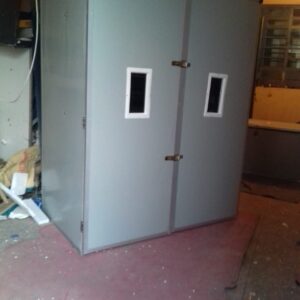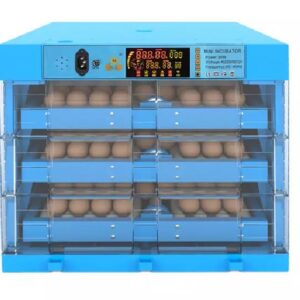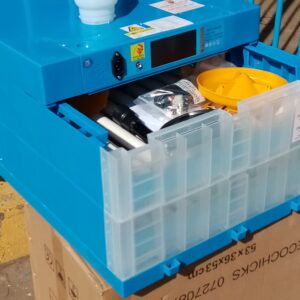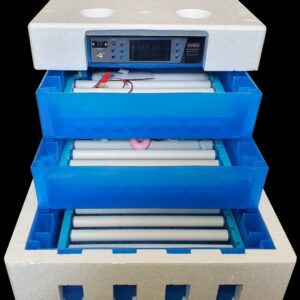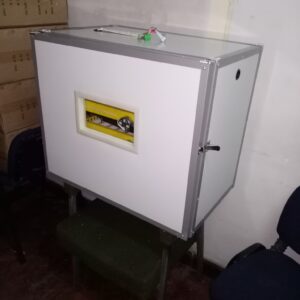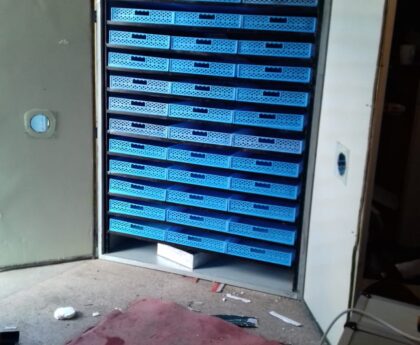Poultry hatcheries are facilities that are designed to incubate and hatch eggs from various species of domesticated birds, such as chickens, turkeys, and ducks. Here are the general steps involved in the operation of a poultry hatchery:
-
 2112 Eggs Incubator, Poultry Hatcher Machine,Dual Control of Humidity and Temperature-Dual Use of Coal and Electricity,Automatic Egg Turning Microcomputer Control Panel.KSh130,000.00
2112 Eggs Incubator, Poultry Hatcher Machine,Dual Control of Humidity and Temperature-Dual Use of Coal and Electricity,Automatic Egg Turning Microcomputer Control Panel.KSh130,000.00 -
Product on sale
 Automatic 192 Eggs Incubator With Built-in Egg And Smart Temperature Humidity Controller LED Candler For Hatch Chicken Duck Goose BirdKSh24,000.00
Automatic 192 Eggs Incubator With Built-in Egg And Smart Temperature Humidity Controller LED Candler For Hatch Chicken Duck Goose BirdKSh24,000.00 -
 128 Eggs Incubator Fully Automatic Breeding Machine Engine Breeding Apparatus with Precise Temperature Sensor and FanKSh20,000.00
128 Eggs Incubator Fully Automatic Breeding Machine Engine Breeding Apparatus with Precise Temperature Sensor and FanKSh20,000.00 -
Product on sale
 192 Eggs Incubator With Automatic For Hatching Eggs Chicken Temperature And Humidity Control With Digital Display LED CandlerKSh24,000.00
192 Eggs Incubator With Automatic For Hatching Eggs Chicken Temperature And Humidity Control With Digital Display LED CandlerKSh24,000.00 -
 128 Eggs Incubator Fully Automatic Breeding Machine Engine Breeding Apparatus with Precise Temperature Sensor and FanKSh20,000.00
128 Eggs Incubator Fully Automatic Breeding Machine Engine Breeding Apparatus with Precise Temperature Sensor and FanKSh20,000.00 -
 300 Eggs Automatic Temperature Humidity Monitoring and Auto Turning, for Hatching Chicken Duck Goose Quail BirdsKSh52,000.00
300 Eggs Automatic Temperature Humidity Monitoring and Auto Turning, for Hatching Chicken Duck Goose Quail BirdsKSh52,000.00 -
Product on sale
 192 Eggs Automatic Egg Incubator With Turning And Humidity Control LED Candler For Hatching Ducks Goose Quail Chicken HouseholdKSh24,000.00
192 Eggs Automatic Egg Incubator With Turning And Humidity Control LED Candler For Hatching Ducks Goose Quail Chicken HouseholdKSh24,000.00 -
 Eggs Incubator with Automatic Egg Turning Water Fulfilling, Humidity Control Temperature Incubators for Hatching Chicken Duck Goose Birds EggsKSh20,000.00
Eggs Incubator with Automatic Egg Turning Water Fulfilling, Humidity Control Temperature Incubators for Hatching Chicken Duck Goose Birds EggsKSh20,000.00 -
Product on sale
 192 Eggs Incubator Automatic Turning with Egg Trays, Temperature Humidity Control Poultry Hatcher for Farm Chickens Ducks Goose BirdsKSh24,000.00
192 Eggs Incubator Automatic Turning with Egg Trays, Temperature Humidity Control Poultry Hatcher for Farm Chickens Ducks Goose BirdsKSh24,000.00
- Egg collection: Eggs are collected from poultry farms and transported to the hatchery.
- Sorting: The eggs are sorted according to their size and quality. Eggs that are damaged or have cracks are removed.
- Incubation: The eggs are placed in incubators, which provide the optimal temperature, humidity, and ventilation for embryonic development.
- Candling: After a few days of incubation, the eggs are candled to check for fertility and embryo development. Candling involves shining a light through the eggshell to visualize the embryo.
- Hatching: After approximately three weeks of incubation, the chicks start to hatch. They use their egg tooth to break open the shell and emerge from the egg.
- Chick processing: The newly hatched chicks are sorted by gender and inspected for any deformities or health problems. They are then vaccinated, debeaked (in some cases), and packed for shipping.
- Shipping: The chicks are shipped to poultry farms or hatcheries, where they will be raised for meat or egg production.
Overall, the operation of a poultry hatchery requires careful monitoring of temperature, humidity, and ventilation to ensure the best possible hatch rates and chick quality. Good hygiene practices and disease prevention measures are also crucial to maintain the health of the chicks and prevent the spread of diseases.


